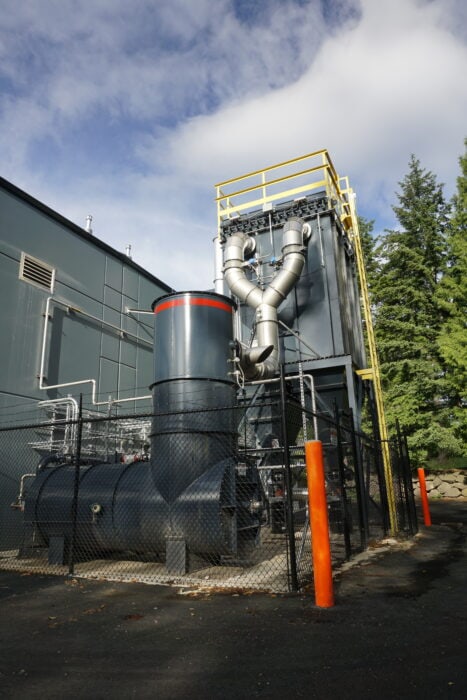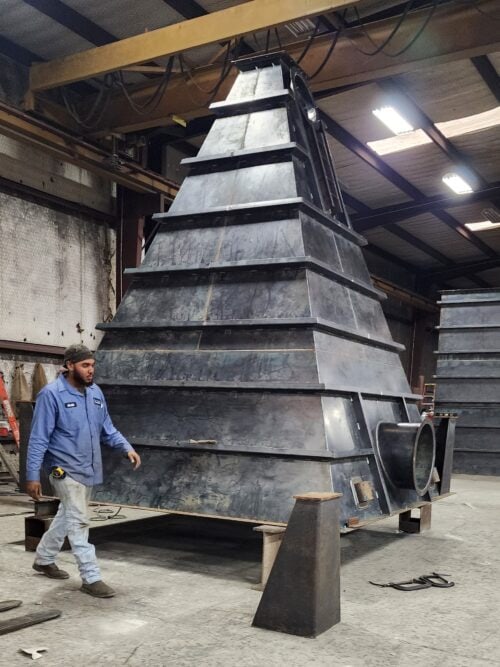The Challenge
In the ever-evolving landscape of energy storage technology, the demand for efficient and sustainable solutions has intensified, prompting a significant shift in the materials utilized for lithium-ion batteries. Anode active materials (AAM) are generally made from carbon-based materials like graphite, silicon, or a combination of the two, with graphite having been the most used anode material due to its high electrical conductivity, low cost, and stable structure. However, silicon carbon-based powder offers 10 times higher capacity and up to 50% more energy density than graphite, a critical solution in this transition from lithium-ion batteries, and a sign that lithium-silicon batteries are the future of energy storage technology.
 Anguil worked with a customer who has a silicon carbon anode powder manufacturing facility creating the next generation anode battery powder. The customer desired to remove the pollutants formed during the manufacturing process, and a factory site in the Northwestern United States was chosen due to the availability of hydroelectric power. In the unique production process, silane gas needed to be destroyed which forms a powder, SiO2. The particulate had to be removed to meet local air emission limits. The customer also wanted the system to have as low of a carbon footprint as possible.
Anguil worked with a customer who has a silicon carbon anode powder manufacturing facility creating the next generation anode battery powder. The customer desired to remove the pollutants formed during the manufacturing process, and a factory site in the Northwestern United States was chosen due to the availability of hydroelectric power. In the unique production process, silane gas needed to be destroyed which forms a powder, SiO2. The particulate had to be removed to meet local air emission limits. The customer also wanted the system to have as low of a carbon footprint as possible.
The Solution
This was a challenging design due to the nature of the process. An inert process stream at a high temperature would be exiting the kilns and there were safety concerns due to the explosive nature of the pollutants and silane. An important aspect of the project was that the equipment needed to handle a significant amount of inorganic particulate that would be formed during the oxidation process. Maintaining high equipment uptime is key for both companies, so on-line cleaning was required.

Anguil was able to work with and collaborate with the kiln original equipment manufacturer (OEM) to give an integrated system on the larger lines. After the pilot line was installed and achieved the guaranteed performance requirements, Anguil was chosen to design and install two larger units on full-scale production lines for the customer.
The Result
For the full-scale production lines, Anguil designed, fabricated, and installed two (2) 9,000 SCFM DFTOs with downstream fabric filter dust collectors. These designs were created to allow for a range of operating conditions to be handled. The layout was also customized to meet site installation requirements and allow for additional future lines.
The full-scale system incorporated many design enhancements compared to the pilot line to ensure equipment uptime. Anguil performed multiple Computational Fluid Dynamics (CFD) analyses on the full-scale DFTO design and collaborated with the customer to optimize the performance and design. Anguil’s ability to provide a custom solution was critical to the customer, and much time and care were utilized to optimize the design to craft a system that can be applied on all future lines. Important design changes increased residence time to meet destruction requirements. These enhancements allowed for on-line cleaning of the heavy inflow of particulate.
The AAM market is expected to continue to grow and evolve swiftly as we discover new information about energy storage technology. Pollution from the process technologies and techniques used to produce batteries can be detrimental to our air, water, and soil if the proper abatement technologies are not applied. Fortunately, Anguil Environmental Systems offers effective, proven technologies that have been applied throughout the production chain; from material mining to powder production, anode coating, battery recycling, and component manufacturing. Anguil is well-positioned to support this ever-evolving market and develop alternate-fuel oxidizer technology.

